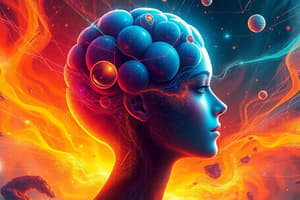Podcast
Questions and Answers
What is meant by the term 'mental spotlight' in the context of attention?
What is meant by the term 'mental spotlight' in the context of attention?
According to filter theory, what happens to information that is deemed unimportant?
According to filter theory, what happens to information that is deemed unimportant?
What type of brain activity measures were used to evaluate the filter theory?
What type of brain activity measures were used to evaluate the filter theory?
The P1 and N1 ERP waves are particularly sensitive to which aspect of attention?
The P1 and N1 ERP waves are particularly sensitive to which aspect of attention?
Signup and view all the answers
Which of the following best describes the selective filter's function?
Which of the following best describes the selective filter's function?
Signup and view all the answers
What mechanism does the brain employ to process urgent or goal-relevant information according to the content?
What mechanism does the brain employ to process urgent or goal-relevant information according to the content?
Signup and view all the answers
In the context of attention, how does William James describe its complexity?
In the context of attention, how does William James describe its complexity?
Signup and view all the answers
Which of the following statements best represents the impact of attention on awareness of surroundings?
Which of the following statements best represents the impact of attention on awareness of surroundings?
Signup and view all the answers
What does the N1 wave reflect in terms of visual processing?
What does the N1 wave reflect in terms of visual processing?
Signup and view all the answers
How does paying attention to a specific visual field affect the P1 and N1 waves?
How does paying attention to a specific visual field affect the P1 and N1 waves?
Signup and view all the answers
What is the main premise of Treisman's Attenuation Theory?
What is the main premise of Treisman's Attenuation Theory?
Signup and view all the answers
Which brain regions are predominantly involved in controlling attention?
Which brain regions are predominantly involved in controlling attention?
Signup and view all the answers
What does the cocktail party effect illustrate about attention?
What does the cocktail party effect illustrate about attention?
Signup and view all the answers
What is the significance of the central executive network?
What is the significance of the central executive network?
Signup and view all the answers
What occurs when individuals direct their attention externally?
What occurs when individuals direct their attention externally?
Signup and view all the answers
At what time frame does the N1 wave typically occur after observing stimuli?
At what time frame does the N1 wave typically occur after observing stimuli?
Signup and view all the answers
Study Notes
Attention and Selective Filtering
- Attention is a selective process: When we focus on one thing, we're less aware of other stimuli. This is like shining a mental spotlight on something, making it stand out.
- Sensory information is processed through input channels: These channels include sights, sounds, and other sensory experiences.
- Filter theory (Broadbent, 1958): This theory suggests that a filter selects information early in mental processing, prioritizing important stimuli and excluding less important ones.
- Filter theory: Early-selection model: This filter operates even before we've fully analyzed the incoming information, at the level of basic visual and auditory processing.
- Filter theory: Goal-relevance: The filter lets in information relevant to our current goals and discards the rest.
- Filter theory: Neurological evidence: Electroencephalogram (EEG) studies show that brain activity associated with attention appears in early visual or auditory areas even before processing in higher regions.
- P1 and N1 ERPs: These are brain waves measured by EEG that reflect early visual processing in the brain. They are sensitive to attention, showing a stronger response when someone is paying attention to a particular location or stimulus.
- Attenuation theory (Treisman, 1964): This theory challenges the filter theory, suggesting that rather than completely blocking out unimportant information, it's simply attenuated (weakened). This explains the "cocktail party effect," where we can focus on a single conversation in a noisy environment, but still notice if our name is mentioned.
- Central executive network: This network, located in the frontal and parietal lobes, is crucial for attention, particularly in directing our attention to relevant information.
- Parietal lobe: Important for representing space around us.
- Frontal lobe: Involves in deciding where to focus attention within that space.
- External vs. internal focus: When we focus on the external world (e.g., listening to a lecture), our attention is directed outward. When we focus on internal thoughts, our attention is withdrawn from the external environment.
Studying That Suits You
Use AI to generate personalized quizzes and flashcards to suit your learning preferences.
Description
Explore the concept of attention and how selective filtering works in cognitive psychology. This quiz covers key theories, including Broadbent's filter theory, and how sensory information is prioritized based on relevance to our goals. Test your understanding of these essential cognitive processes!




